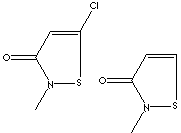PRODUCT IDENTIFICATION

H.S. CODE
TOXICITY
CLASSIFICATION
Disinfectant, Thiazoline, Fungicide, Bactericide, Preservative
EXTRA NOTES
PHYSICAL AND CHEMICAL PROPERTIES
Clear light amber liquid
AUTOIGNITION
NFPA RATINGS
Health hazard: 3, Fire: 0, Reactivity Hazard: 0
REFRACTIVE INDEX
Stable under ordinary conditions. Light sensitive
EXTERNAL LINKS & GENERAL DESCRIPTION
http://apps.kemi.se/
Isothiazolines
are used as preservatives in the paint industry, where they serve
to protect the product from fungal and mould attacks. One of the
more common products of this kind used to be Kathon®, a 1.5%-aqueous
solution consisting of 1 part methylisothiazolinone (CAS No 2682-20-4),
and 3 parts of chloromethylisothiazolinone (CAS No 26172-55-4).
This mixture can also be identified with a specific CAS No, 55965-84-9.
To avoid risk of allergy the much weaker 1,2-benzisothiazolinone
(commonly called BIT) is used. This is above all used as a preservative
in latex paints. These substances are used in paint, adhesives,
jointing compounds, cutting fluids and detergents. Paint, adhesive
and detergents are products sold for both professional and consumer
use.
http://ec.europa.eu/
Kathon��
886 Biocide (current process) is defined as a combination of the
two active ingredients produced by an integrated production process,
resulting in an approximate total of 14% active ingredients, 16%
magnesium nitrate, 10% magnesium chloride and 62% water.
The
"mixture of 5-Chloro-2-methyl-isothiazol-3(2H)-one and 2-Methylisothiazol-3(2H)-one
with magnesium chloride and magnesium nitrate" is currently
regulated as a preservative in the cosmetic directive (76/768/EEC)
in annex VI, part 1, entry 39 with the maximum authorized concentration
0.0015% (15 ppm) of the mixture. The submission describes Kathon��
CG as cosmetic grade at 1.5% active ingredient stabilized with magnesium
nitrate. It is the formulated product sold to customers for cosmetic
applications. Kathon�� CG is a cosmetic preservative. The main uses
are rinse-off products, such as shampoos, conditioners, gels and
surfactants. The EU use concentration is a maximum of 15 ppm a.i.
for rinse-off and leave-on products. However, the manufacturers
recommend a maximum level of 7.5 ppm a.i. (0.05% by weight of product
as supplied) for leave-on products. The manufacturers recommend
CMI/MI as a preservative in shower gels, body washes, bubble baths,
liquid soaps, shampoos, hair conditioners and wipes. The CMI/MI
mixtures have wide applications in household (domestic) and industrial
products.
Local:
Isothiazolinones containing sulfur atom (S), nitrogen (N), oxygen (O) at 3 position and hydrogen (H) can find application for making broad-spectrum biocides and preservatives such as antiseptic agents, bactericides, slimicides, and fungicides. The biggest application is
in paint industry especially marine antifouling agent. They are also used in
adhesives, cutting oils, water systems, cosmetics, household goods and wound
protectant for pruning cuts. They are also used as pulp and wood impregnating agents
as well as in leather, fur and polymer process. It is known to cause allergy and chemical burn if high concentration is used in personal care products and cosmetics.
The list of isothiazolinones include
|
Material |
CAS # |
EINECS # |
| (4-Chlorobenzyl)-3(2H)-isothiazolone | 26530-09-6 |
|
| 1,2-Benzisothiazolin-3-one | 2634-33-5 | 220-120-9 |
| 2-Butyl-1,2-benzisothiazolin-3-one | 4299-07-4 |
|
| 2-Methyl-4,5-trimethylene-4-isothiazolin-3-one | 82633-79-2 |
|
| 2-Methyl-4-isothiazolin-3-one | 2682-20-4 | 220-239-6 |
| 2-Methyl-3-isothiazolone hydrochloride | 26172-54-3 |
247-499-3 |
| 2-Octyl-3(2H)-isothiazolone | 26530-20-1 | 247-761-7 |
| 4,5-Dichloro-2-cyclohexyl-4-isothiazolin-3-one | 57063-29-3 |
|
| 4,5-Dichloro-2-octyl-3(2H)-isothiazolone | 64359-81-5 | 264-843-8 |
| 4-Chloro-2-octyl-3(2H)-isothiazolone | 64359-80-4 | 264-842-2 |
| 5-Chloro-2-(4-chlorophenylmethyl)-3(2H)-isothiazolone | 66159-95-3 |
|
| 5-Chloro-2-methyl-4-isothiazolin-3-one | 26172-55-4 | 247-500-7 |
| 5-Chloro-2-methyl-3(2H)-isothiazolone, calcium chloride complex | 57373-19-0 |
|
5-Chloro-2-methyl-2H-isothiazol-3-one hydrochloride |
26530-03-0 |
247-760-1 |
| 2-Methyl-4-isothiazolin-3-one calcium chloride | 57373-20-3 |
|
Mixtures of these materials |
|
|
APPEARANCE
Clear light amber liquid
ASSAY
14.0 - 14.5%
CMIT
10.1 - 11.3%
MIT
3.0 - 4.2%
SPECIFIC GRAVITY
1.26 - 1.32
pH VALUE
1.0 - 4.0
PRICE INFORMATION